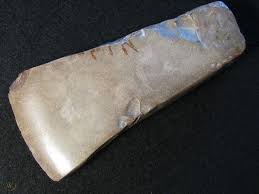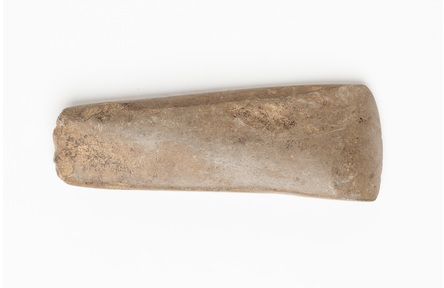177: Stone Age Aotearoa
- MD
- Oct 2, 2021
- 6 min read
Stone Age - Origin of the Term and Definition
The Stone Age was first defined in the 19th century by Christian Jurgensen Thomsen as the earliest period of human history. He considered the Stone Age to be a time when most technology and tools were made of stone. The Stone Age was part of the three-age system which divides the human story into the Stone Age, the Bronze Age, and the Iron Age. Around 2 million years ago, a new human species appeared which is referred to as Homo ergaster. Homo ergaster was supposedly the first human species to have an anatomically modern body design with legs significantly longer than the arms. Skeletal remains suggest that they were also very tall, as much as 6 feet (1.8 meters). At the same time that H. ergaster appears in the fossil record, more advanced stone tools appear in the archaeological record. These tools are flake tools that have been modified by removing smaller flakes from them to create a more specialized shape. One example of these next generation stone tools is the ‘hand axe’.
The Middle Palaeolithic
Around 400,000 years ago, early humans began developing the ‘prepared-core technique’, a technique in which tools could be made by splitting off flakes of a pre-determined size and shape. This control over the end-result of the process allowed for diversification and standardization of the sorts of tools that could be made.
This development probably represents another advance in cognition because such an elaborate stone-tool making technique requires even greater skill and deliberation than previous tool-making traditions. Hafted tools, tools that are placed on wooden handles, also first appear during this period. It is also during the Middle Palaeolithic that the first spears with stone spear points were probably made.
The Upper Palaeolithic
The Upper Palaeolithic is characterized by more advanced tools made of more diverse materials. These tools include stone blades, which were more elongated and more finely crafted then earlier tools.
The Upper Palaeolithic is marked by the emergence of most of the aspects of culture generally considered unique to H. sapiens , such as art and religion. Although there is emerging evidence that Neanderthals also produced art, most artwork and figurines are still associated with H. sapiens .
It is also during the Upper Palaeolithic that humans arrived in Australia and the Americas for the first time in prehistory. H. sapiens were the first and only known human species to colonize these regions.
Neolithic – The New Stone Age
The term Neolithic means ‘New Stone Age’. The Neolithic is typically considered to have begun about 12,000 years ago. Around this time, the earliest farming communities began to emerge.
Above are two adzes, one is 4400 years old and the other is Maori and only 500-600 years old.
The Stone Age – Beginning of Early Human Societies
The rise of agriculture allowed for the rise of large settlements and very large populations. These populations led to social structures which had not yet existed, including chiefdoms and states.
The stone age in Europe was said to end when tools began to be made out of metals. It ended generally around 3300BC when Bronze began to be smelted and formed into tools and weapons.
*****
Once, a few years ago, we used the term 'stone age' on our first Facebook page in reference to pre-European Maori. Some truly dull woman got upset as she misunderstood the reference to the term. We asked her what 'age' it was, bronze or iron? She could not answer of course, few who try take us on can. She went on to say that if Europeans hadn't arrived, Maori would have been producing iron on their own by now! OMG, It appears some have a warped sense of romanticism and misunderstanding about their own culture at times.
But if you ever use the term 'stone age' be prepared to be accused of applying the term 'primitive' or 'backward' toward a people. There are many who will see the title above and will be self-baited into making racist comments without reading this whole article. Trying to suggest we mean stone age as unintelligent beings who droolled and said 'ug' to each other and dragged their women off by the hair, shows a truly simple mind. The stone age in my mind simply means a time when humans (anywhere and at any time) used stone tools exclusively before discovering how to make bronze tools and weapons or were introduced to them. Sure, Europeans aren't known to have much that is provable in the way of arts and 'culture' for the 'official' European stone age. It was called the 'stone' age as afterward they progressed to the 'bronze' age. Maori did not and never could have. That's not saying anything other than what it says. But compared to the old European 'stone age' cultures, the more recent 'stone age' peoples had, or still have, very rich cultures. They just lived in places and numbers that prevented them from finding metals. Even now, the Sentinelese in the Andaman Islands use metal salvaged from shipwrecks on their island, but they are essentially a 'stone age' people in terms of how they live. I love that, I think the Sentinelese way of life is to be admired and likely the best way of life on the planet, but they had to kill all outsiders to attain and retain it.
All of the Pacific Islands including Aotearoa, were essentially in a ‘stone’ age because - and here's the butt clenching revelation - stone was used! But their societal structure, religion and practices were as complex as any other culture, except they had no written language. Art was intricate and melded with their religious beliefs. Some higher than thou Polynesian could be tempted to say those we refer as European stone age had no culture or religion? Really? Where's the proof? They could have easily have had a very real culture and to say otherwise smacks of racial supremacism.
Unfortunately, Darwin's theory of evolution was directly responsible for Europeans seeing those without metal weapons and transport, as somehow less civilized. That form of racism came straight out of interpretation of Darwin's theories. Now, instead of being ranked in a hierarchy of evolution, human cultures were seen as internally coherent social and political systems. Indigenous worldviews were no more or less “advanced” than Western ones. Had Europeans never arrived here in NZ, stone tools would still be used today. You know it, Maori know it, we all know it. So what? I love those stone tools. They had meaning and much skill and time went into the making of them. The Sentinelese, of the remote island in the Andamans, now use metal in arrow heads, as they see iron as superior, but they can only scavenge it from shipwrecks on the reef for they cannot make it themselves.
Maori too, when shown metal axes, willingly, eagerly and of their own volition, abandoned their old tools and way of life in favour of the advanced, sharper and stronger tools. Many tools were simply thrown away as they held no value. In other words they very quickly abandoned their cultural tool making. Let's repeat that one - they 'abandoned'.... Yes, Europeans were indirectly responsible for this loss, but Maori chose it. Let's repeat that... they chose it! This was their choice, no one else's, as they saw iron as vastly superior. Around that time, the way Maori dressed, how they housed themselves and how they worked, all changed as they drifted from the cultural way of life they were used to for hundreds, if not thousands of years - all within a short period of 20 years after 1815. They sought, and even coveted, the new ways, the new materials, and the new lifestyle. They could have worn traditional clothing but they chose not to - often to their detriment.

Make no mistake though, it was the Maori that kept many early settlers alive with food when they realised the early settlers couldn’t farm the European way so easily in this land. Many early settlers would have died of starvation if it were not for their Maori neighbours. Up until European times they used stone tools for sure, but they were far from unsophisticated. We would even suggest they were more sophisticated than the Europeans at one point, especially while they held to their 'traditional' ways that had worked for them for so long...
More sophisticated than that crazy women on Facebook we mentioned above.



















































Comments